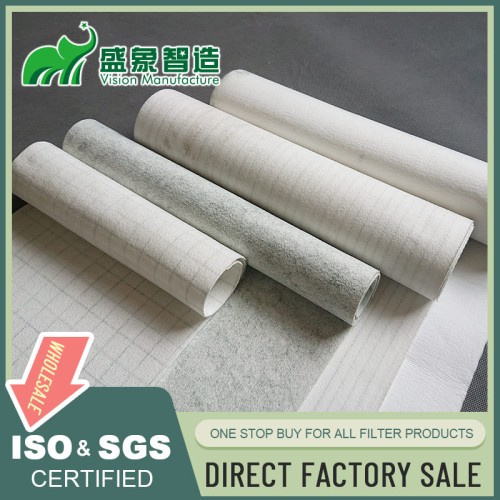
High Temperature Felt: Advanced Material for Extreme Filtration Needs
I. Introduction
High-temperature filtration presents unique challenges in industrial processes, requiring materials that can withstand extreme conditions without compromising performance. High temperature felt is crucial in these settings, offering robust solutions that enhance operational efficiency and ensure product integrity.
High-temperature filtration presents unique challenges in industrial processes, requiring materials that can withstand extreme conditions without compromising performance. High temperature felt is crucial in these settings, offering robust solutions that enhance operational efficiency and ensure product integrity.
II. Types of High Temperature Felt
- Aramid (e.g., Nomex) Felt: Known for its heat resistance and durability, suitable for applications up to 220°C.
- Fiberglass Felt: Offers excellent thermal resistance and dimensional stability up to 550°C.
- PPS (Polyphenylene sulfide) Felt: Handles temperatures up to 190°C and offers good chemical resistance.
- PTFE (Polytetrafluoroethylene) Felt: Exceptional chemical and heat resistance, suitable for temperatures up to 260°C.
III. Properties and Characteristics
- Temperature Resistance Ranges: Each material is suited to specific temperature ranges, ensuring performance under high heat.
- Chemical Compatibility: Resistant to a wide range of chemicals, preventing degradation and maintaining filtration efficiency.
- Mechanical Strength and Durability: Engineered to withstand harsh conditions, reducing wear and tear.
- Filtration Efficiency: High efficiency in removing particulates, even at elevated temperatures.
IV. Manufacturing Process
- Fiber Selection and Preparation: Careful selection based on the application's temperature and chemical exposure requirements.
- Needle Punching Techniques: Mechanically entangles fibers to increase durability and filtration capability.
- Heat Setting and Finishing: Processes that stabilize the fibers and enhance their intrinsic properties.
- Quality Control Measures: Rigorous testing to ensure that felts meet industry standards and performance specifications.
V. Applications Across Industries
- Cement and Lime Production: Handles high temperatures and abrasive particles.
- Steel and Metal Processing: Captures metal fumes and particulates during high-temperature processing.
- Power Generation Plants: Filters flue gases and particulates in coal-fired and gas turbines.
- Waste Incineration Facilities: Effective in controlling emissions and capturing ash.
- Chemical and Petrochemical Industries: Provides resistance to corrosive gases and high temperatures.
- Glass Manufacturing: Filters fine particulates and gaseous pollutants at high temperatures.
VI. Performance in High-Temperature Environments
- Stability at Extreme Temperatures: Maintains structural integrity and performance under high heat.
- Resistance to Thermal Degradation: Materials are selected to resist breakdown from prolonged heat exposure.
- Maintenance of Filtration Efficiency: Continues to effectively remove particulates despite harsh conditions.
- Longevity and Replacement Frequency: Designed to last longer, reducing the need for frequent replacements.
VII. Design Considerations
- Felt Thickness and Density: Tailored to enhance filtration efficiency and durability.
- Surface Treatments and Finishes: May include treatments to improve dust cake release and cleanability.
- Integration with Support Structures: Ensures compatibility with existing systems and enhances performance.
- Customization for Specific Applications: Custom designs to meet unique operational demands.
VIII. Installation and Maintenance
- Proper Handling and Installation Techniques: Ensures optimal performance and longevity.
- Break-in Procedures: Essential for conditioning the felt to perform at its best.
- Cleaning and Regeneration Methods: Techniques suited to the felt material and application.
- Monitoring and Replacement Guidelines: Regular checks to ensure ongoing performance and safety.
IX. Advantages Over Traditional Filter Materials
- Extended Service Life in Extreme Conditions: Reduces operational disruptions and maintenance costs.
- Improved Filtration Efficiency at High Temperatures: Ensures cleaner emissions and product purity.
- Reduced Maintenance and Downtime: Durable materials decrease the frequency of filter changes.
- Enhanced Emissions Control: Meets stringent environmental regulations.
X. Cost-Benefit Analysis
- Initial Investment Considerations: Evaluates the upfront costs against the long-term benefits of durability and efficiency.
- Long-term Operational Savings: Lower maintenance and replacement costs contribute to overall savings.
- Energy Efficiency Improvements: Efficient systems reduce energy consumption during operation.
- Compliance Cost Reduction: Helps meet regulatory standards, avoiding potential fines.
XI. Environmental and Safety Aspects
- Emissions Reduction Capabilities: Significantly lowers particulate and chemical emissions.
- Workplace Safety Enhancements: Improves air quality, enhancing worker safety.
- Disposal and Recycling Practices: Encourages responsible end-of-life handling of used felts.
XII. Innovations and Future Trends
- Advanced Fiber Technologies: Developments in fiber chemistry that enhance heat and chemical resistance.
- Hybrid and Composite Felts: Combines different materials for optimized performance.
- Smart Monitoring Integration: Incorporates sensors to monitor filter performance in real-time.
- Sustainable Manufacturing Practices: Focuses on reducing environmental impact through eco-friendly materials and processes.
XIII. Case Studies and Success Stories
Examples from various industries demonstrate how high-temperature felt has solved complex filtration challenges, improved process efficiency, and enhanced compliance with environmental regulations.
Examples from various industries demonstrate how high-temperature felt has solved complex filtration challenges, improved process efficiency, and enhanced compliance with environmental regulations.
XIV. Conclusion
High-temperature felt is an indispensable component in modern industrial filtration, offering unmatched performance in extreme conditions. As industries continue to face challenging environmental and operational demands, these advanced materials are crucial for maintaining efficiency and compliance.
High-temperature felt is an indispensable component in modern industrial filtration, offering unmatched performance in extreme conditions. As industries continue to face challenging environmental and operational demands, these advanced materials are crucial for maintaining efficiency and compliance.
Leave a comment

